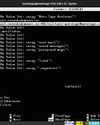UBUNTU VS FEDORA
Linux Format
|December 2021
Jonni Bidwell wants to know everything – and he means everything – about the two most popular Gnome-based distros…

Fedora and Ubuntu are both highly regarded distros, but have different approaches in a number of areas. If you were to believe the first few Google results comparing them, you’d conclude that Ubuntu is more suited to beginners, that Fedora features new technology first, and that both have large companies backing them. But these listicle summaries rarely tell the full story, so to celebrate the release of new versions of each we thought it’d be a fine time to really put these OSes to the test.
We’ll look at software availability, gaming prowess as well as some technical points about how each is put together. The flagship releases of both distros run Gnome and both use the Wayland desktop protocol, so there’s not much to compare there. The interim Ubuntu releases are supported for nine months, whereas Fedora is supported for only seven. If these two months matter to you, you’ve already got some use out of this feature. But if you want to know more about how in-place upgrades work for both, then you’ll have to read a little further.
We’ll also look at each specimen’s server offerings. Ubuntu’s cloud-init tool makes it easy to set up a new server, and Fedora’s Cockpit tool will have you administrating like a pro in no time. If you’re into IoT then Ubuntu Core with its Snap-powered modularity will get your embedded projects up and running. Fedora’s CoreOS Linux is ideal if you want to run container-based workloads. And there’s also Fedora Silverblue, powered by OSTree atomic updates.
Okay, time to pit Orange against Blue in a fight to the, urm, kernel panic.
What makes them great, again?
Here at Linux Format Towers we’re always recommending both Ubuntu and Fedora, but sometimes we forget why…
Cette histoire est tirée de l'édition December 2021 de Linux Format.
Abonnez-vous à Magzter GOLD pour accéder à des milliers d'histoires premium sélectionnées et à plus de 9 000 magazines et journaux.
Déjà abonné ? Se connecter
PLUS D'HISTOIRES DE Linux Format

Linux Format
Create your first WebSocket service
Mihalis Tsoukalos explains how to use the Go programming language to work with the WebSocket protocol.
9 mins
April 2023

Linux Format
Fantastic Mr Firefox
Nick Peers takes a trip down memory lane to reveal the story behind the rise - and slight fall - of Mozilla's popular web browser.
9 mins
April 2023

Linux Format
Set up your terminal and email like it's 1983
Jump in the hot terminal time machine with Mats Tage Axelsson who emails from the command line using the latest technology.
8 mins
April 2023

Linux Format
Universal layer text effects with GIMP
Posters use them, films and presentations are hard to imagine without them: text effects. Attract attention with Karsten Günther and GIMP.
8 mins
April 2023

Linux Format
Jump to a federated social network
Nick Peers reveals how you can get up and running with this free, decentralised and non-profit alternative to Twitter.
9 mins
April 2023

Linux Format
Free our SOFTWARE!
Taking anything for granted is dangerous, so Jonni Bidwell and Mike Saunders revisit how the free software movement got started to help free us from proprietary tyranny!
4 mins
April 2023

Linux Format
Master RPI.GPIO
Les Pounder goes back to the early days of the Raspberry Pi - and his career with this classic library! -
5 mins
April 2023

Linux Format
Waveshare Zero to Pi3
Transform your Pi Zero into a Pi 3, they promised Les Pounder, but it's more like adding on go-faster stripes.
2 mins
April 2023

Linux Format
The Best OPEN SOURCE Software Ever!
In an attempt to trigger controversy, Michael Reed and Neil Mohr unequivocally state these are the greatest free software apps ever. Probably. We’re just trying to be helpful.
19 mins
April 2023

Linux Format
Linux-Mandrake 7
Simplicity and a wide range of applications make this a great distribution for all Linux users.
2 mins
April 2023
Translate
Change font size

